Philippines, island country of Southeast Asia in the western Pacific Ocean. It consists of some 7,100 islands and islets lying about 500 miles (800 km) off the coast of Vietnam. Manila is the capital, but nearby Quezon City is the country’s most-populous city. The second largest island of the Philippines is Mindanao, in the southeast. The Philippines takes its name from Philip II, who was king of Spain during the Spanish colonization of the islands in the 16th century. Rich in resources, the Philippines has the potential to build a strong industrial economy, but the country remains largely agricultural.

CULTURAL MILIEU
Philippine society is a unique blend of diversity and homogeneity. The Philippines is a country that has varied cultural influences. Most of these influences are results of previous colonization, deriving mainly from the culture of Spain and the United States. Despite all of these influences, the old Asian culture of Filipinos has been retained and is clearly seen in their way of life, beliefs and customs.
Filipino culture is very evident and has largely been appreciated and even applauded in many parts of the world. The Philippines can be a bit of a mystery: a rich fusion of influences and cultures often leaves visitors stumped for definition.
From cockfighting, competitive karaoke, to the world’s longest Christmas season, here are some of the main traditions only Filipinos can fully appreciate.
Filipinos are very fond of music. They use various materials to create sound. They love performing dances (Tiniking and Carinosa) and group singing during festive celebrations. Settlers from Spain introduced to them a variety of musical instruments like the ukulele, trumpet, drums and violin.
Most of their music is contemporary and they have also learned to write their own songs based on real life events. People are also fond of folklore, which was influenced by the early church and Spanish literature. Jose Rizal, the country’s national hero, is famous for his literature and novels inspired from the independence story of the country.


- Competitive Karaoke : Often naturally musical, Filipinos take to karaoke from a young age. It’s common for families to have a karaoke machine, several mikes, and heaps of old ’80s love ballads on disc. But the real reason this pastime is venerated, aside from the fact it’s fun, is that a beautiful voice – and with it the chance to break out of poverty and achieve stardom – is a dream many natives hold dear.
- Cockfighting : Although it seems like a bloody and even cruel pastime to outsiders, within the Philippines cockfighting is just a part of life. Hopes, dreams, and fortunes are pinned onto the fate of these carefully bred birds. Cockfighting rings are a common sight even in the cities, and there are countless birds being raised for the ring at any time in the countryside. Generally the domain of men, the sport draws crowds to assess, bet, and cheer on the winners – they also eat the losers.
3. Courting : The Filipino way of wooing is still called courting, and its rituals can feel quite old-fashioned. Catholic women are expected to stay virgins until marriage, and so courting is generally a dignified and polite way for teenage boys and girls to get to know each other. “Suitors” – interested males may “send their regards”, shower females with gifts over the years, and go on dates supervised by a chaperone. Of course, much of the younger generation is keen to get away from these old norms, but the traditional practice is still rife among middle-class families.
4. The three-month Christmas : While this sounds like a fun idea, three months of carols can get a bit tedious. A deeply religious nation, Filipinos adopted Christmas traditions from the Spaniards and built onto those, adding some twists and rituals of their own. The decorating and music starts in October, and reaches a fever pitch in the days before December 24. Early-morning mass, midnight feasting, and diligent gift-buying all feature in the festive period. The colorful ‘parol’ (Christmas star lantern) symbolizes the holiday across the islands.
5. Beach Outing : Filipinos have a habit of preparing a lot of food, piling into some kind of transport, and spending the whole day at the beach in a rented bamboo gazebo called a bahay kubo. Fearful of darkening their skin, Filipinos often swim fully clothed. They make multiple trips between the water and the table, where there may be several indulgent dishes and even a whole grilled pig (if it’s a special occasion).


6. Street Parades : Filipinos love their parades. Each village and city has its own “fiesta”, which it celebrates in unique style, and there are many more festive occasions throughout the year that call for an organized march through the streets. One of the biggest street festivals in the country, Cebu’s Sinulog runs for several days, with raves, beauty pageants, and dance competitions all thrown into the mix. Filipino parades often involve schools and universities competing in elaborate costumes and choreographed dance routines.
7. Family dinners at Jollibee : Jollibee – a local fast-food chain is more popular in the Philippines than McDonald’s and has mastered the Filipino palate. Its burgers, spaghetti, and fried chicken are a cut above what many locals are able to afford on a daily basis. Come payday, or a special occasion, a trip with the kids to Jollibee is a highlight. Even when children have grown up and gone on to much fancier dining venues, these family dinners retain a nostalgia that can’t be fulfilled elsewhere.
TRADITIONS


Here are some unique traditions that embody the local beliefs and values inculcated through the centuries.
- Pagmamano : Practiced as a sign of respect to elders, pagmamano is one of the oldest and most notable Filipino tradition there is. Mano means hand in Spanish, fittingly so as pagmamano is done by gently tapping the hand of the elder to a younger person’s forehead. The elder in return says “God bless you” hence why the act is also often referred to as “bless”.
2. Kamayan : FIlipinos love to eat and when the food is especially sumptuous, they eat kamayan-style. From the Filipino word kamay or hand, kamayan is the traditional way of dining using one’s bare hands.
3. Fiesta Celebrations : If there’s a celebration you wouldn’t wanna miss out on while you’re in the Philippines, it would be the colorful fiestas happening all-year round. Celebrating fiesta is another influence of the Spanish colonizers and was mainly done to honor the patron saints.
4. Harana : The traditional Filipino courtship is an extremely long process and one way to “woo” a girl is through doing a harana or serenading. With his friends in tow, the guy goes to the girl’s house (usually at night) and sings classic kundiman or folk love songs to her until she opens her window and invites him inside her house.
5. Pamamanhikan : Once the panliligaw (courtship) stage has been surpassed, all the possible harana (serenade) has been sung, and the couple finally gets together, next comes the pamamanhikan. Well, if the couple decides to marry, that is. Pamamanhikan is the formal act of a guy asking the girl’s family for her hand in marriage. It usually involves the guy’s family bringing over gifts and discussing the couple’s plans for marriage.
6. Bayanihan : Although not as evident as it was before, bayanihan truly captures the strong sense of community Filipinos have and is usually exemplified through helping a neighbor transfer houses. Traditionally, bayanihan meant your neighbors literally carrying your entire kubo(native nipa hut) to your new home location.
FESIVALS
Members of extended families typically gather for major life events such as baptisms and confirmations (for Catholic Filipinos), circumcisions (for Muslim Filipinos), and marriages, as well as for major religious and other national holidays.
Other celebrations include Christmas and Easter, as well as Eid al-Fitr, which marks the end of the Muslim fasting month of Ramadan. Holidays include New Year’s Day, Labor Day (May 1), and Independence Day (June 12).
Whether festival fare or everyday food, major meals in most Filipino societies are built around boiled or steamed rice or rice noodles. Small amounts of meat, including chicken, pork (in non-Muslim communities), goat, or fish complement the rice or noodle core, along with an assortment of fruits and cooked vegetables.
Assorted alcoholic drinks are made from coconut sap, sugarcane, and rice. Balut, a parboiled embryonic duck still in the egg, is a popular street food in the Manila area.


- Ati Atihun ( Celebrating infant Jesus ) : Come January, people begin preparing for the Christian festival that commemorates Santo Niño (Infant Jesus). The town of Kalibo, Aklan in the Panay Island rejoices in the exultations of this festival as people celebrate by performing tribal dance and music in the parade along the streets.
2. Kaamulan (Experience tribal culture) : Malaybalay City, Bukidnon is the venue for its extraordinary festival beginning in the second half of February and extends to March 10. This one-of-its-kind jubilation glorifies culture and tradition of seven ethnic Filipino tribes of the province. This festival is an amalgamation of a thanksgiving ritual for good harvest, a peace pact amongst all the tribes, a datuship ritual and a wedding ceremony. Tribal dances elevate the conviviality and gaiety in the atmosphere.
3. Anibina Bulawanun : The resplendent festival of Anibina Bulawanun that lasts for a week. The name ‘Anibina’ consists of two terms, ‘Ani’ meaning ‘harvest’ and ‘bina’ indicating ‘gold veins.’ As the name suggests, the festival rejoices in the abundant agricultural harvest in the Compostela Valley, famous for its mineral deposits. The festival intertwines in the exultations the different themes highlighting the natural prosperity of Compostela Province.
4. Moriones Festival (Mourning Christ’s sacrifice) : April sees masked men and women in costumes resembling those of biblical Roma soldiers during Moriones Festival in the island of Marinduque in the Philippines. This festival is a motley of rituals as it depicts the story of the Passion of Christ. It has derived its name from the masks worn by people as these were known as Morion helmets.
People reminisce the sacrifice of Jesus Christ and chant verses from the Bible. They also act out the suffering of the Christ. The Festival begins on Holy Monday and ends on Easter Sunday.
5. Flores de Mayo (Invoke blessings of Virgin Mary) : This is a month-long festival held in the entire country in the month of May. People evoke their devotions for Blessed Virgin Mary and glorify the finding of the True Cross by Helena of Constantinople and Constantine the Great.
People organize processions through the streets and march dressed as Biblical figures. As part of rituals, people recite the rosary and offer flowers and prayers to an image of Mary every night. After the procession and rituals, people share food and snacks. This is one of the unique festivals in Philippines.
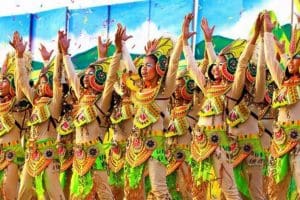
6. The Pineapple Festival ( Relish the Pineapple season) : The Pineapple Festival is held every year from June 15 to June 24 in the Daet district. It celebrates a unique variety of pineapple fruit only produced in this region and is called ‘Queen of Formosa.’ People take out colorful parades, where they march and dance in the streets in fanciful costumes. The dances and celebrations are choreographed, rehearsed and present an engaging sight to the onlookers. The festival uplifts the art and culture of the region and also gives a boost to its agricultural industry.
7. Bocaue Pagoda (Journey into Banaue history) : Just as July knocks on the door comes Bocaue River Festival in the town of Bocaue in Bulacan. Held on the first Sunday of July, it commemorates the discovery of the miraculous cross floating on the Bocaue River 200 years ago. People create a replica of this cross and parade it through the streets of the city. A procession is also taken down the river with a huge elaborately decorated pagoda float.
8. Pangapog (Thanking the harvest) : August welcomes Pangapog Festival in Samal City, Davao del Norte. Held from 1st to 7th of August, people offer thanksgiving for the abundant harvest in this festival. The festival begins with ‘Panawag Tawag’ ritual performed by Babaylan Teresita Lugam in Sama tongue. This succeeds with revelries and rejoicing that includes a brilliant motorcade accompanied by singing and dancing.
9. Hin-Ay (Rejoice in Rich Reaps) : Hin-Ay or Paray festival is celebrated by the land-locked, rice-producing community of Irosin, Sorsogon as thanksgiving for the rich harvest. The festival lasts for the entire month of September and ends with the feast of St. Michael the Archangel – the patron saint of the local parish church – on September 29. The festival highlights three themes through its activities: harvest festival, street dancing, and culture and sports.
10. Halaran Festival (Travel back in time) : The arrival of October brings the festival of Halaran in Roxas City, Capiz. Depicting the kaleidoscopic history of the Capizeños, the events held during this festival take people back to the earliest time of settlement of the Bornean Datus. The festival lasts the whole first week of October and raises the high spirits through eating, drinking and dancing to the resonant beat of drums.
11. Pintaflores (Exulting in the beauty of flowers) : November brings to the city of San Carlos, the delightful festival of Pintaflores or flower tattoos. This gorgeous festival explodes in bright hues as people dance with their bodies painted in different colors and wearing floral costumes. It is held from November 3 to November 5 and reminisces the beginnings of San Carlos.
12. Giant Lantern Festival (Conquering darkness with light) : December gets illuminated by the Giant Lantern Festival held for the entire month in the city of San Fernando. Its giant lanterns give this festival subtle and mesmerizing charm and it also features competition of such lanterns. San Fernando City got the nickname of ‘Christmas Capital of the Philippines’ because of this festival.
FOODS
Filipinos are big eaters, even though it is not obviously seen in their petite bodies. The Philippines is known as Asia’s melting pot because of the uniqueness and variety of their food. Filipinos can’t go a day without including rice in their meals. They love plain rice matched with salted fish, chicken and meat. They serve rice first followed by the various viands they have grown to eat and cook. Filipinos have a very regular eating schedule: morning, mid-morning, lunch, afternoon (merienda) and dinner.


They enjoy a variety of sweet foods adopted from other countries which encouraged them to make their own desserts like “mahablanca” a dessert made of coconut milk, corn, sugar, or “puto” and “palitaw” which are also made of coconut milk. They also enjoy eating “halo-halo” for their afternoon snack, which means “mixture,” a popular dessert that consists of layers of cornflakes, ice cream, small pieces of gelatin, milk and shaved ice.
During special occasions like a town’s big event in celebration of their saint’s feast, a favorite food called “lechon,” a suckling pig that has been roasted until the skin turns crusty is served. Some street foods are also common in the country like the famous “balut,” a boiled duck egg with an embryo, and fish and squid balls on a stick that are dipped on spicy and sweet sauces.
Some other delicacies include:
- Chicken adobo : the famous Filipino dish
- Balut : the Filipino Kinder surprise
- Kare Kare : Oxtail Stew
- Kinilaw: raw fish salad
- Sinigang: sour meat stew
- Lechon: roasted suckling pig
- Tapsilog: the King of Filipino breakfast
- Halo halo: the best Filipino dessert
- Buko Pie : the divine Filipino coconut pie
- Arroz Caldo : the Filipino porridge
DANCES
The Philippines has many popular folk dances which have evolved and changed as they have been passed down from generation to generation. Although a particular dance might be performed slightly differently from one region to the next, its remains true to its roots. Here are some of the most popular dances from the region.
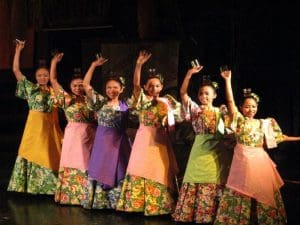

- The Itik Itik : The best description of the Itik-Itik is that the steps mimic the way a duck walks, as well as the way it splashes water on its back to attract a mate. According to popular tradition, the dance was created by a lady named Kanang who choreographed the steps while dancing at a baptismal party. The other guests copied her movements, and everyone liked the dance so much that it has been passed along ever since.
2. The tinkling : The Tinikling is considered by many to be the Philippines’ national dance. The dance’s movements imitate the movement of the tikling bird as it walks around through tall grass and between tree branches. People perform the dance using bamboo poles. The dance is composed of three basic steps which include singles, doubles and hops. It looks similar to playing jump rope, except that the dancers perform the steps around and between the bamboo poles, and the dance becomes faster until someone makes a mistake and the next set of dancers takes a turn.
3. The Sayaw sa Bangko : The Sayaw sa Bangko is performed on top of a narrow bench. Dancers need good balance as they go through a series of movements that include some impressive acrobatics. This dance traces its roots back to the areas of Pangapisan, Lingayen and Pangasinan.
4. The Binasuan : The Binasuan is an entertaining dance that is usually performed at festive social occasions like weddings and birthdays. Dancers carefully balance three half-filled glasses of rice wine on their heads and hands as they gracefully spin and roll on the ground. The dance originated in Bayambang in the Pangasinan province, and though it’s usually performed alone, it can also become a competition between several dancers.
5. The Panddanggo sa Ilaw : The Pandanggo sa Ilaw is similar to a Spanish Fandango, but the Pandanggo is performed while balancing three oil lamps – one on the head, and one in each hand. It’s a lively dance that originated on Lubang Island. The music is in 3/4 time and is usually accompanied by castanets.
TRIBES
Although there are quite a number of indigenous tribes or ethnic groups in the country, they remain some of the most poor, least privileged, and impeded members of society. They mostly reside in the mountains, and hence were not affected by Spanish or American colonization, which is the primary reason they were able to retain their customs and traditions.
There are two main ethnic groups comprising several upland and lowland indigenous tribes living within the Philippines – from the northern and southern parts of the Philippines. The indigenous people living in the northern part of the country are called the Igorots, whereas those non-Muslim indigenous tribes living in the south are referred to as Lumad.


- Badjaos : Originally from the islands of Sulu in Mindanao, they’re known as the sea tribes living on houseboats. They try to make ends meet by depending on the sea as divers, fishermen, and navigators. Because of conflicts in the region, the majority of them has migrated to neighboring countries such as Malaysia and Indonesia, whereas those who stayed in the Philippines moved to some areas in Luzon.
2. Ati and Tumandok : One of the few clans in Visayas, the Ati and Tumandok tribes of Panay Island are the first to call the island their home. Genetically related to other indigenous groups in the country, they mostly resemble the Aetas or Negritos who are characterised by their dark skin. While some adopted Western religions, they still carry some animistic beliefs and rituals passed down by their ancestors.
3. Palawan : Palawan is also home to various tribes such as the Batak, Palaweño, Palawano, and the Tagbanwa. Mostly living in mountains or lowland dwellings, some of these groups have also been included in the large Manobo tribe of the South. They have not totally embraced urban living, with the majority living in more rural settings.
4. Mangyan : The Mangyans of Mindoro are well-known clans in the Philippines because they have the biggest populace. Comprising eight different Mangyan groups, they have a peaceful reputation, unlike the headhunting tribes of the North and warrior tribes from the South. While some has already converted into Christianity, there’s still a large percentage of those who practice animistic religious beliefs.
5. Aetas / Negritos : The Aetas (or Agta or Ayta) are one of the earliest known inhabitnats of the Philippines who are now living in scattered mountainous areas of the country. They were called by the Spanish colonizers as the ‘Negritos’because of their dark to dark-brown skin. They are nomadic but are very skilled in weaving and plaiting, and Aeta women are considered experts in herbal medicine.
6. Igorots : The Igorots, which comprises numerous tribes in the northern part of the country, are mostly residing in the mountain ranges of the Cordillera Region. They are popularly known for being rice cultivators. An assortment of the group called the Ifugaos built the Banaue Rice Terraces – frequently called the ‘eighth wonder of the world’. The ancestors of this indigenous tribe carved a system of irrigated rice terraces in the mountains of Ifugao more than 2,000 years ago.
EMBROIDERIES
The embroidery tradition in the Philippines was born in the town of Taal, Batangas during the turn of the century. It has been a refined art in the society because of its intricate well-embossed appearance. It belongs to one of the finest arts in the world.
The materials used in embroidery are Piña and other traditional fabrics. The former is a soft, flexible, and durable fine off-white fabric that is derived from the best mature leaves of the red Spanish variety of pineapple. During the Spanish times, piña was the most expensive fabric for Barong Tagalog on very rare and special events.
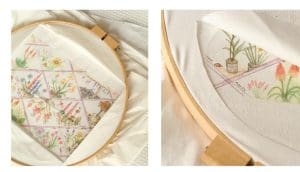
Embroidery is a very remarkable Philippine art and now it has been associated with many other native Philippine products that are being exported to almost all parts of the world. Now we have embroidered abaca bags and embroidered raffia bags that all come in good quality, one hundred percent handmade from the trusted Filipino hands. Aside from the weaved banig bags that are also a new trend today, this additional beautification of embroidering has made bags, clutches, hats, and other products look even more good and unique.
WOMEN’S CLOTHING

Baro’t Saya ( Shirt and skirt ) is the Filipino style of women’s clothing. Traditionally, it is composed of a blouse and a long skirt with a “panuelo”. It evolved many variants and some are regional. The upper class women wore more elaborate baro’t saya sewn with beads and has colorful designs. The skirt is also wider than what lower classes wore. These types of clothing that are “simple yet functional” that have both indigenous Filipino qualities and Spanish influence started to become prominent during the 16th century in the Philippines.
Such clothing, through the innovation of modern-day Filipino fashion designers, can be worn in the Philippines for formal occasions and office uniforms. These “national clothes” can be made from materials such as piña, jusi, abaca, and Mindanao silk.
MEN’S CLOTHING

Barong Tagalog is a clothing item worn by men. Having originated in Luzon, this clothing is may be made of pineapple fiber and is translucent, where an undershirt has to be worn together with dark pants. The “coat” or “suit”, locally known as the “Amerikana” was another type of clothing introduced to the Philippines by the Americans.
TRADITIONAL CLOTHING BY AREAS AND REGIONS
- Cordilleras: Igorot ethnic outfit
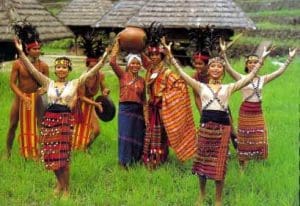
The Igorots are indigenous people from the Cordilleras. They are known for wearing a piece of clothing with intricate patterns woven by their own fellowmen. The men’s clothing consists of red loincloth called wanes with tribal patterns, tattoos which is a symbol for bravery, and colorful bead necklaces. Women’s clothing are usually similar to men’s except that the women wear wrap-around skirt or called lufid and usually topless. In some parts of Cordilleras such as the Igorots in Benguet, women wrap their breasts with a very detailed wrap-around clothing.
2. Baro’t Saya
The traditional Baro’t Saya was worn by the lowland people in Filipinas. It includes the blouse called “baro” and a skirt called “saya”. It is the Archetype of every Filipiniana dress that has evolved through out the colonial era of the Philippines. Today, the dress represents the rural life in the Philippines.
URBAN AREAS
- Maria Clara Dress

Being the capital which is also located in the lowland Urban area, Manila people often wore more elaborate version of Baro’t Saya with wide full skirts rather than the simple skirt. Throughout the 17th–18th century, this clothing also became popular to the upper and middle class Filipinos from other parts of the country, mostly urban areas such as Cebu, Iloilo, Negros Occidental and many more. Today, it is now known as the Maria Clara gown which represents the Spanish colonial history of the country as well as the aristocracy of the Filipino people.
During the American period, the design drastically changed from a wide full skirt to a more modern look and then again changed into the current Filipiniana popularized by Imelda Marcos in the 1960s. Men wore Barong Tagalog but with also a more elaborate and intricate designs.
2. Kimona and Patadyong
In the islands of the Visayas regions, the Kimona represents Visayan clothing. Most Visayas lowland people wear the typical Kimona, a type of Baro’t Saya blouse matching with a knee-length skirt.

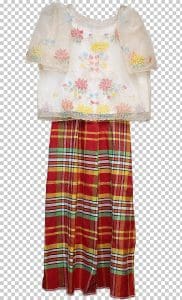
Kimona is typically a transparent piece of clothing made of pineapple fiber while the skirt is usually either floor-length or knee-length printed with the Patadyong pattern, hence getting the name Patadyong skirt. The dress is often accompanied with a handkerchief called tubao and is often placed above the right shoulder.
3. Mindanao
In Mindanao, there is large mintority of the people are practicing Islam, therefore following the Islamic culture. Women wear a hijab, a long-sleeved top and a floor-length skirt, while men wear polos and pants together with a hat called taqiyah. Non Islamic people follow Visayan-like fashion.
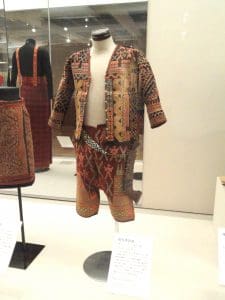
By Vasavi Mehta
References :
[Download] Textiles, Philippines. by United States. International Trade Administration. PDF EPUB FB2
The Philippines: Culture and Tradition – Globalization Partners International
Philippines | History, Map, Flag, Population, Capital, & Facts | Britannica
Philippines | History, Map, Flag, Population, Capital, & Facts | Britannica
Philippines | History, Map, Flag, Population, Capital, & Facts | Britannica
7 Traditions Only Filipinos Can Understand
6 Truly Unique Filipino Traditions | Philippine Primer
12 Festivals In Philippines 2020 To Soak In The Culture!
The Art of Philippine Embroidery – Our 7107 Islands
